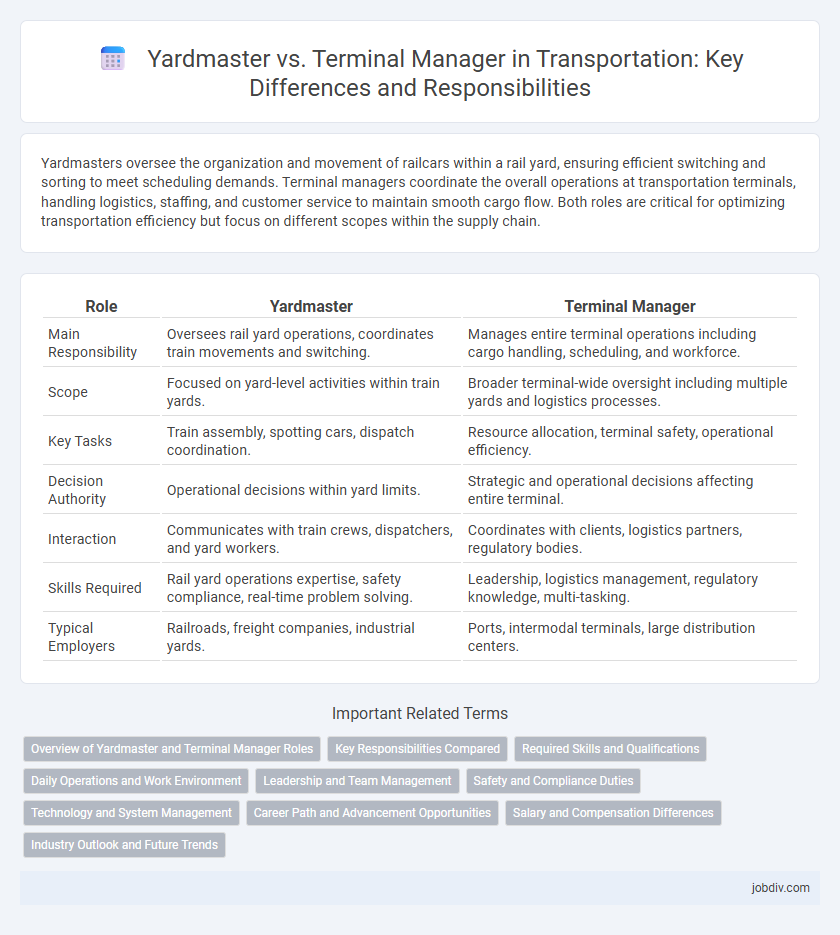Yardmasters oversee the organization and movement of railcars within a rail yard, ensuring efficient switching and sorting to meet scheduling demands. Terminal managers coordinate the overall operations at transportation terminals, handling logistics, staffing, and customer service to maintain smooth cargo flow. Both roles are critical for optimizing transportation efficiency but focus on different scopes within the supply chain.
Table of Comparison
| Role | Yardmaster | Terminal Manager |
|---|---|---|
| Main Responsibility | Oversees rail yard operations, coordinates train movements and switching. | Manages entire terminal operations including cargo handling, scheduling, and workforce. |
| Scope | Focused on yard-level activities within train yards. | Broader terminal-wide oversight including multiple yards and logistics processes. |
| Key Tasks | Train assembly, spotting cars, dispatch coordination. | Resource allocation, terminal safety, operational efficiency. |
| Decision Authority | Operational decisions within yard limits. | Strategic and operational decisions affecting entire terminal. |
| Interaction | Communicates with train crews, dispatchers, and yard workers. | Coordinates with clients, logistics partners, regulatory bodies. |
| Skills Required | Rail yard operations expertise, safety compliance, real-time problem solving. | Leadership, logistics management, regulatory knowledge, multi-tasking. |
| Typical Employers | Railroads, freight companies, industrial yards. | Ports, intermodal terminals, large distribution centers. |
Overview of Yardmaster and Terminal Manager Roles
Yardmasters coordinate the movement of railcars within railway yards, ensuring efficient switching, sorting, and organization of rail equipment to maintain smooth yard operations. Terminal Managers oversee the entire terminal facility, including scheduling, logistics, and personnel management to facilitate the seamless transfer of goods between different transportation modes. Both roles are critical for optimizing freight flow and operational efficiency in transportation hubs.
Key Responsibilities Compared
Yardmasters primarily oversee the efficient movement and organization of railcars within the rail yard, ensuring proper switching, spotting, and dispatching to maintain smooth operations. Terminal Managers handle broader terminal functions, including coordinating incoming and outgoing shipments, managing staff across various departments, and optimizing terminal logistics to improve throughput and reduce delays. Both roles require strong operational oversight, but Yardmasters focus on rail yard operations, while Terminal Managers emphasize overall terminal efficiency and resource management.
Required Skills and Qualifications
Yardmasters require strong organizational skills, expertise in logistics coordination, and proficiency in managing rail yard operations, often needing certifications in rail safety and equipment handling. Terminal Managers must demonstrate leadership abilities, knowledge of supply chain processes, and experience in overseeing terminal activities, typically holding degrees in logistics or business administration. Both roles demand excellent communication skills and proficiency in safety compliance and operational efficiency.
Daily Operations and Work Environment
Yardmasters coordinate daily rail yard activities, managing train assembly, car movement, and crew assignments to ensure efficient flow and safety. Terminal Managers oversee broader terminal operations, including cargo handling, scheduling, and intermodal transfers, optimizing overall logistics performance. Both roles demand strong communication and problem-solving skills but differ in scope, with Yardmasters emphasizing on-the-ground rail operations and Terminal Managers focusing on strategic terminal management.
Leadership and Team Management
Yardmasters coordinate rail yard operations by directing train movements and managing switch crews to ensure efficient freight handling. Terminal Managers oversee broader facility functions, including staff supervision, logistics coordination, and process optimization to maintain terminal productivity. Leadership for Yardmasters centers on tactical decision-making in high-pressure environments, while Terminal Managers emphasize strategic team management and cross-departmental collaboration.
Safety and Compliance Duties
Yardmasters oversee the safe movement of railcars within the yard, ensuring compliance with federal safety regulations such as OSHA and FRA standards while coordinating with train crews to prevent accidents. Terminal Managers implement comprehensive safety programs, enforce regulatory compliance across all terminal operations, and manage risk assessments to uphold industry standards and reduce workplace incidents. Both roles are critical in maintaining operational safety and regulatory adherence, but Terminal Managers have broader oversight of terminal-wide compliance initiatives.
Technology and System Management
Yardmasters leverage real-time tracking systems and automated scheduling software to optimize railcar movements within the yard, enhancing operational efficiency and minimizing dwell time. Terminal Managers use integrated terminal operating systems (TOS) that manage cargo flow, equipment allocation, and workforce deployment across the entire terminal, ensuring seamless coordination and throughput. Advanced data analytics and IoT technologies empower both roles to monitor performance metrics, predict maintenance needs, and improve decision-making processes in transportation logistics.
Career Path and Advancement Opportunities
Yardmasters typically begin their careers overseeing train movements within rail yards, gaining critical operational experience before advancing to roles such as Terminal Manager, where they manage entire terminal operations and coordinate multiple departments. Career advancement from Yardmaster to Terminal Manager often requires strong leadership skills, knowledge of logistics, and proficiency in safety regulations, providing broader responsibilities and higher salary potential. Terminal Managers have expanded oversight with opportunities to progress into regional operations management or executive roles within transportation companies.
Salary and Compensation Differences
Yardmasters typically earn an average salary ranging from $60,000 to $75,000 annually, reflecting their direct oversight of yard operations and crew coordination. Terminal Managers often command higher compensation packages, with salaries between $80,000 and $120,000, due to their broader responsibilities in managing terminal facilities, logistics, and staff performance. Benefits, bonuses, and experience levels further influence the total compensation disparity between these two key transportation management roles.
Industry Outlook and Future Trends
Yardmasters and Terminal Managers play pivotal roles in transportation logistics, with Yardmasters primarily overseeing rail yard operations and Terminal Managers handling broader facility and cargo management. Industry outlooks reveal a growing emphasis on automation and real-time data analytics to enhance efficiency and safety within yards and terminals. Future trends suggest increased integration of AI-driven systems and IoT technologies to optimize asset utilization and improve the coordination between yard and terminal functions.
Yardmaster vs Terminal Manager Infographic

 jobdiv.com
jobdiv.com